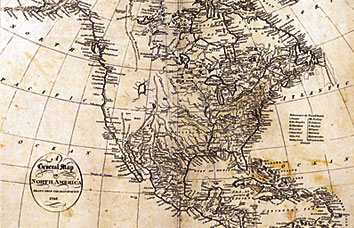We’ve launched a new web portal! Visit findhistory.nd.gov to search our collections.
Due to a road closure, the Killdeer Mountain Battlefield State Historic Site is temporarily closed.
 George Rogers Clark:
George Rogers Clark:
The older brother of William Clark, George Rogers won enduring fame
for his exploits during the Revolutionary War. He was originally one
of Thomas Jefferson’s first choices to head up a small expedition
to explore the upper reaches of the Missouri River.
John Ledyard:
One of the early proposed explorers of the Trans-Mississippi west
during the 1780's, Ledyard approached Jefferson with a less than credible
proposal to walk across Russia, cross the Bering Strait, and then
walk across North America to Philadelphia where he planned to submit
his report of what he had found. His small expedition was arrested
in Russia when Catherine the Great became suspicious and effectively
ended what was a dubious plan at best.
John Sinclair:
Yet another early explorer Thomas Jefferson tapped to map out the
upper reaches of the Missouri River. An army officer like Meriwether
Lewis, his small expedition got as far as St. Louis when he determined
an upstream trip was not feasible. Despite Sinclair and the others
failures, Jefferson never gave up and eventually chose Meriwether
Lewis and William Clark to lead an expedition–a choice that
could not have been more appropriate nor successful.
Hunter and Dunbar:
At virtually the same time that Lewis and Clark were sent on their
epic journey, explorers/surveyors Hunter and Dunbar were sent to map
out the lower reaches of the Louisiana Purchase. While not nearly
as publicly noticed as Lewis and Clark, Hunter and Dunbar nonetheless
provided a valuable service in determining the dividing line between
American and Spanish possessions in the south. Though not without
disputes with the Spanish, American claims were established and set
the stage for the division of the Louisiana Territory with a minimum
of conflict.
General James Wilkinson:
James Wilkinson today holds the reputation of being among the worst
traitors in American History, perhaps second only to Benedict Arnold.
While military head of the trans- Appalachian west, he secretly negotiated
with the Spanish and conspired with Aaron Burr for the creation of
a state independent of the United States. Although never caught, he
continued as a top US military official and Spanish spy. It was his
information that led to the capture of Zebulon Pike in the American
Southwest.
Zebulon Pike:
A less than capable explorer, Pike first came to public attention
when he was assigned the take of finding the headwaters of the Mississippi
River in Minnesota. For a number of reasons, part of which was his
competency as an explorer, he had difficulty with this task. With
this inauspicious beginning, it is something of a mystery as to why,
in 1809, he was chosen to find the northern boundary of Spanish possessions
in the American Southwest. This mystery is explained when one realizes
that it was General James Wilkinson who chose him for the task. Wilkinson
was a paid agent of the Spanish for many years and kept them abreast
of American plans for the southeast, the Louisiana Purchase, exploration
of the same. Pike again became confused on this trip and ended up
in Colorado where he discovered the mountain today bearing his name.
The Spanish later arrested Pike when, after finally finding the Red
River and Spanish boundary, built a post on the wrong side of the
river. His command was sent to Mexico City where he was eventually
released.
Address:
612 East Boulevard Ave.
Bismarck, North Dakota 58505
Get Directions
Hours:
State Museum and Store: 8 a.m. - 5 p.m. M-F; Sat. & Sun. 10 a.m. - 5 p.m.
We are closed New Year's Day, Easter, Thanksgiving Day, and Christmas Day. We are closed at noon Christmas Eve if it falls on Mon.-Thurs. and are closed all day if it falls on Fri.-Sun.
State Archives: 8 a.m. - 4:30 p.m. M-F, except state holidays; 2nd Sat. of each month, 10 a.m. - 4:30 p.m. Appointments are recommended. To schedule an appointment, please contact us at 701.328.2091 or archives@nd.gov.
State Historical Society offices: 8 a.m. - 5 p.m. M-F, except state holidays.
Contact Us:
phone: 701.328.2666
email: history@nd.gov
Social Media:
See all social media accounts